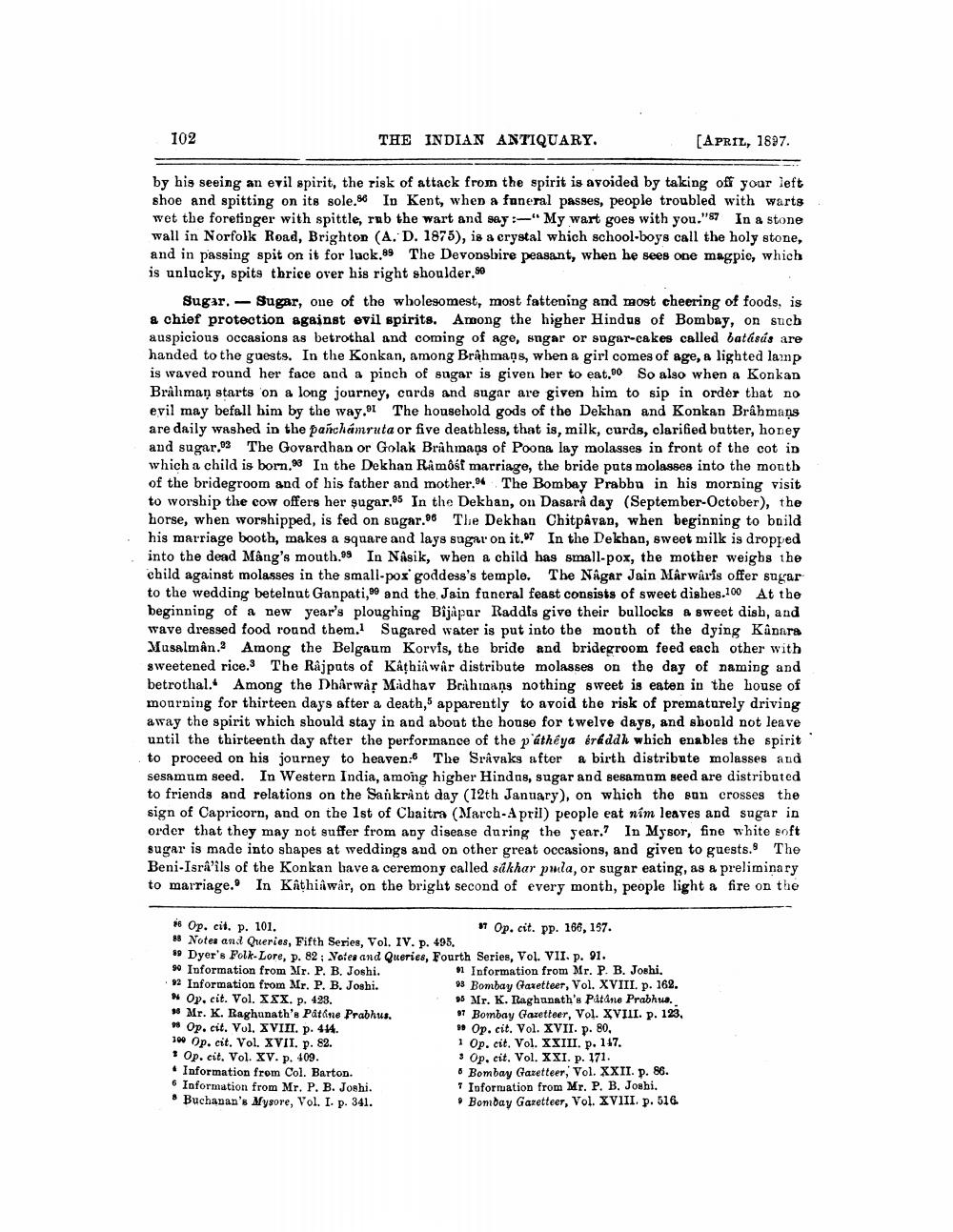________________
102
THE INDIAN ANTIQUARY.
[APRIL, 1897
by his seeing an evil spirit, the risk of attack from the spirit is avoided by taking off your left shoe and spitting on its sole.Sc In Kent, when a funeral passes, people troubled with warts wet the forefinger with spittle, rab the wart and say :-"My wart goes with you." In a stone wall in Norfolk Road, Brighton (A. D. 1875), is a crystal which school-boys call the holy stone, and in passing spit on it for luck.89 The Devonsbire peasant, when he sees one magpie, which is unlucky, spits thrice over his right shoulder.80
Sugar. - Sugar, one of the wholesomest, most fattening and most cheering of foods, is a chief protection against evil spirits. Among the higher Hindus of Bombay, on sucb auspicious occasions as betrothal and coming of age, engar or sugar-cakes called batasús are handed to the guests. In the Konkan, among Brahmaps, when a girl comes of age, a lighted lamp is waved round her face and a pinch of sugar is given her to eat.80 So also when a Konkan Brahman starts on a long journey, cards and sugar are given him to sip in order that no evil may befall him by the way. The household gods of the Dekhan and Konkan Brâhmans are daily washed in the pañchámruta or five deathless, that is, milk, curds, clarified butter, honey and sugar.02 The Govardhan or Golak Brahmans of Poona lay molasses in front of the cot in which a child is born. In the Dekhan Ramośt marriage, the bride puts molasses into the mouth of the bridegroom and of his father and mother. The Bombay Prabba in his morning visit to worship the cow offers her şugar.95 In the Dekhan, on Dasará day (September October), the horse, when worshipped, is fed on sugar.96 The Dekhan Chitpávan, when beginning to build his marriage booth, makes a square and lays sugar on it. In the Dekban, sweet milk is dropped into the dead Mâng's mouth.99 In Nasik, when a child has small-pox, the mother weighs the child against molasses in the small-pox' goddess's temple. The Nagar Jain Marwaris offer sugar to the wedding betelnut Ganpati, and the Jain funeral feast consists of sweet dishes.100 At the beginning of a new year's ploughing Bijapar Raddis give their bullocks a sweet dish, and wave dressed food round them. Sagared water is put into the month of the dying Kanara Musalman. Among the Belgaum Korvis, the bride and bridegroom feed each other with sweetened rice. The Rajputs of Kathiâ war distribute molasses on the day of naming and betrothal. Among the Dharwar Midhav Brahmaņs nothing sweet is eaten in the house of mourning for thirteen days after a death, apparently to avoid the risk of prematurely driving away the spirit which should stay in and about the house for twelve days, and should not leave until the thirteenth day after the performance of the pathêya érkddk which enables the spirit to proceed on his journey to heaven: The Srâvaks after a birth distribute molasses and sesamum seed. In Western India, among higher Hindas, sugar and sesamom seed are distribated to friends and relations on the Sankrant day (12th January), on which the sun crosses the sign of Capricorn, and on the 1st of Chaitra (March-April) people eat ním leaves and sugar in order that they may not suffer from any disease during the year.? In Mysor, fine white soft sugar is made into shapes at weddings and on other great occasions, and given to guests. The Beni-Isra'ils of the Konkan bave a ceremony called såkhar pula, or sugar eating, as a preliminary to marriage. In Kathiawar, on the bright second of every month, people light a fire on the
*6 Op. cit. p. 101.
1 Op. cit. pp. 166, 157. 18 Notes and Queries, Fifth Series, Vol. IV. p. 495. * Dyer's Polk-Lore, p. 82: Votes and Queries, Fourth Series, Vol. VII. p. 91. 90 Information from Mr. P. B. Joshi.
» Information from Mr. P. B. Joshi. 92 Information from Mr. P. B. Joshi.
93 Bombay Gazetteer, Vol. XVIII. p. 162. * Op. cit. Vol. XXX. p. 423.
95 Mr. K. Raghanath's Pitane Prabhus. » Mr. K. Raghunath's Påtone Prabhus.
97 Bombay Gazetteer, Vol. XVIII. p. 123, * Op. cit. Vol. XVIII. p. 414.
* Op. cit. Vol. XVII. p. 80. 100 Op.cit. Vol. XVII. p. 82.
1 Op.cit, Vol. XXIII. p. 117. ? Op.cit. Vol. XV. p. 409.
• Op. cit, Vol. XXI. p. 171. • Information from Col. Barton.
• Bombay Gazetteer, Vol. XXII. p. 86. 6 Information from Mr. P. B. Joshi.
Infornuation from Mr. P. B. Joshi. * Buchanan's Mysore, Vol. I. p. 341.
. Bombay Gazetteer, Vol. XVIII. p. 516




